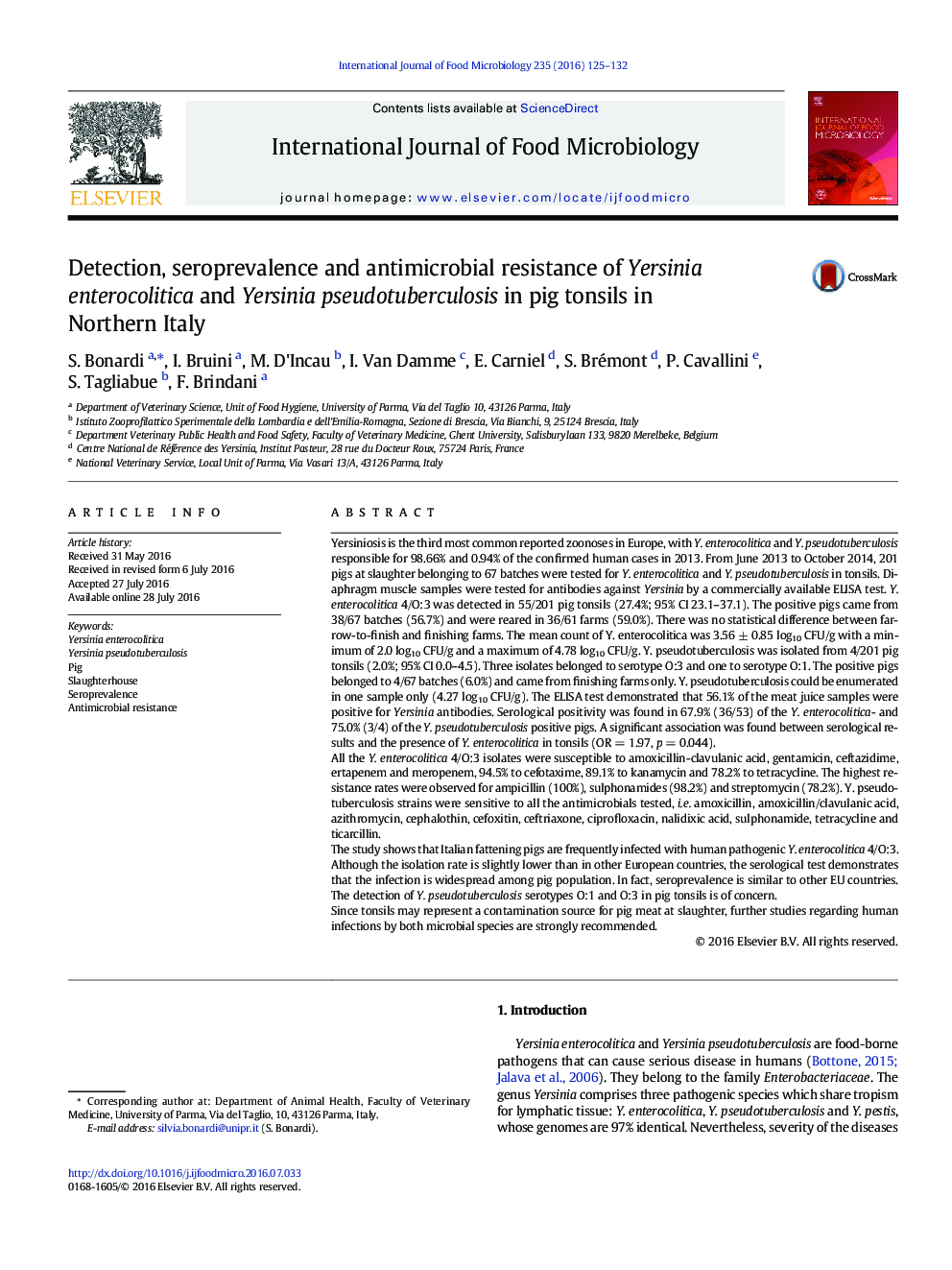| کد مقاله | کد نشریه | سال انتشار | مقاله انگلیسی | نسخه تمام متن |
|---|---|---|---|---|
| 4366169 | 1616548 | 2016 | 8 صفحه PDF | دانلود رایگان |

• Detection of Y. pseudotubeculosis O:1 and O:3 in pig tonsils
• Insensitiveness of the ISO method compared to direct plating and cold enrichment
• Higher prevalence of Yersinia -positive pigs by serology than cultural methods
• High levels of antimicrobial resistance in Y. enterocolitica 4/O:3
• Sensitivity to all antimicrobials tested for Y. pseudotuberculosis O:1 and O:3
Yersiniosis is the third most common reported zoonoses in Europe, with Y. enterocolitica and Y. pseudotuberculosis responsible for 98.66% and 0.94% of the confirmed human cases in 2013. From June 2013 to October 2014, 201 pigs at slaughter belonging to 67 batches were tested for Y. enterocolitica and Y. pseudotuberculosis in tonsils. Diaphragm muscle samples were tested for antibodies against Yersinia by a commercially available ELISA test. Y. enterocolitica 4/O:3 was detected in 55/201 pig tonsils (27.4%; 95% CI 23.1–37.1). The positive pigs came from 38/67 batches (56.7%) and were reared in 36/61 farms (59.0%). There was no statistical difference between farrow-to-finish and finishing farms. The mean count of Y. enterocolitica was 3.56 ± 0.85 log10 CFU/g with a minimum of 2.0 log10 CFU/g and a maximum of 4.78 log10 CFU/g. Y. pseudotuberculosis was isolated from 4/201 pig tonsils (2.0%; 95% CI 0.0–4.5). Three isolates belonged to serotype O:3 and one to serotype O:1. The positive pigs belonged to 4/67 batches (6.0%) and came from finishing farms only. Y. pseudotuberculosis could be enumerated in one sample only (4.27 log10 CFU/g). The ELISA test demonstrated that 56.1% of the meat juice samples were positive for Yersinia antibodies. Serological positivity was found in 67.9% (36/53) of the Y. enterocolitica- and 75.0% (3/4) of the Y. pseudotuberculosis positive pigs. A significant association was found between serological results and the presence of Y. enterocolitica in tonsils (OR = 1.97, p = 0.044).All the Y. enterocolitica 4/O:3 isolates were susceptible to amoxicillin-clavulanic acid, gentamicin, ceftazidime, ertapenem and meropenem, 94.5% to cefotaxime, 89.1% to kanamycin and 78.2% to tetracycline. The highest resistance rates were observed for ampicillin (100%), sulphonamides (98.2%) and streptomycin (78.2%). Y. pseudotuberculosis strains were sensitive to all the antimicrobials tested, i.e. amoxicillin, amoxicillin/clavulanic acid, azithromycin, cephalothin, cefoxitin, ceftriaxone, ciprofloxacin, nalidixic acid, sulphonamide, tetracycline and ticarcillin.The study shows that Italian fattening pigs are frequently infected with human pathogenic Y. enterocolitica 4/O:3. Although the isolation rate is slightly lower than in other European countries, the serological test demonstrates that the infection is widespread among pig population. In fact, seroprevalence is similar to other EU countries. The detection of Y. pseudotuberculosis serotypes O:1 and O:3 in pig tonsils is of concern.Since tonsils may represent a contamination source for pig meat at slaughter, further studies regarding human infections by both microbial species are strongly recommended.
Journal: International Journal of Food Microbiology - Volume 235, 17 October 2016, Pages 125–132